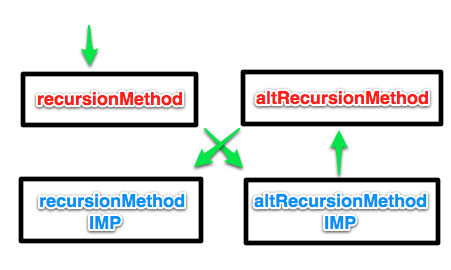[Cocoa]深入浅出Cocoa之 Method Swizzling
CC许可,转载请注明出处
在前文深入浅出Cocoa之消息中,我简要介绍了ObjC 中消息的基本情况,包括SEL查找,缓存以及消息转发等。在本文中,我要介绍一个很有趣的技术,Method swizzling,通过这个手法,我们可以动态修改方法的实现,从而达到修改类行为的目的。当然,还有其他办法(如 ClassPosing,Category)也可以达到这个目的。ClassPosing 是针对类级别的,是重量级的手法,Category 也差不多,比较重量级,此外 Category 还无法避免下面的递归死循环(如果你的代码出现了如下形式的递归调用,应该考虑一下你的设计,而不是使用在这里介绍的 Method Swizzling 手法,:))。
// Bar
//
@implementation Bar
- (void) testMethod
{
NSLog(@" >> Bar testMethod");
}
@end
// Bar(BarCategory)
//
@implementation Bar(BarCategory)
- (void) altRecursionMethod
{
NSLog(@" >> Bar(BarCategory) recursionMethod");
[self altRecursionMethod];
}
@end
在前文深入浅出Cocoa之消息中提到,ObjC 中的类(class)和实例(instance)都是对象,类对象有自己的类方法列表,实例对象有自己的实例方法列表,这些方法列表(struct objc_method_list)是存储在 struct objc_class 中的。每个方法列表存储近似 SEL:Method 的对,Method 是一个对象,包含方法的具体实现 impl。由此可知,我们只需要修改 SEL 对应的 Method 的 impl 既可以达到修改消息行为的目的。下面来看代码:
void PerformSwizzle(Class aClass, SEL orig_sel, SEL alt_sel, BOOL forInstance)
{
// First, make sure the class isn't nil
if (aClass != nil) {
Method orig_method = nil, alt_method = nil;
// Next, look for the methods
if (forInstance) {
orig_method = class_getInstanceMethod(aClass, orig_sel);
alt_method = class_getInstanceMethod(aClass, alt_sel);
} else {
orig_method = class_getClassMethod(aClass, orig_sel);
alt_method = class_getClassMethod(aClass, alt_sel);
}
// If both are found, swizzle them
if ((orig_method != nil) && (alt_method != nil)) {
IMP temp;
temp = orig_method->method_imp;
orig_method->method_imp = alt_method->method_imp;
alt_method->method_imp = temp;
} else {
#if DEBUG
NSLog(@"PerformSwizzle Error: Original %@, Alternate %@",(orig_method == nil)?@" not found":@" found",(alt_method == nil)?@" not found":@" found");
#endif
}
} else {
#if DEBUG
NSLog(@"PerformSwizzle Error: Class not found");
#endif
}
}
void MethodSwizzle(Class aClass, SEL orig_sel, SEL alt_sel)
{
PerformSwizzle(aClass, orig_sel, alt_sel, YES);
}
void ClassMethodSwizzle(Class aClass, SEL orig_sel, SEL alt_sel)
{
PerformSwizzle(aClass, orig_sel, alt_sel, NO);
}
让我们来分析上面代码:
1,首先,区分类方法和实例方法;
2,取得 SEL 对应的 Method;
3,修改 Method 的 impl,在这里是通过交换实现的。
上面的代码是可以工作的,但还不够完善。Apple 10.5 提供了交换 Method 实现的 API: method_exchangeImplementations 。下面我们使用这个新 API,并以 NSObject category的形式给出新的实现方式:
#if TARGET_OS_IPHONE
#import <objc/runtime.h>
#import <objc/message.h>
#else
#import <objc/objc-class.h>
#endif
// NSObject (MethodSwizzlingCategory)
//
@interface NSObject (MethodSwizzlingCategory)
+ (BOOL)swizzleMethod:(SEL)origSel withMethod:(SEL)altSel;
+ (BOOL)swizzleClassMethod:(SEL)origSel withClassMethod:(SEL)altSel;
@end
@implementation NSObject (MethodSwizzlingCategory)
+ (BOOL)swizzleMethod:(SEL)origSel withMethod:(SEL)altSel
{
Method origMethod = class_getInstanceMethod(self, origSel);
if (!origSel) {
NSLog(@"original method %@ not found for class %@", NSStringFromSelector(origSel), [self class]);
return NO;
}
Method altMethod = class_getInstanceMethod(self, altSel);
if (!altMethod) {
NSLog(@"original method %@ not found for class %@", NSStringFromSelector(altSel), [self class]);
return NO;
}
class_addMethod(self,
origSel,
class_getMethodImplementation(self, origSel),
method_getTypeEncoding(origMethod));
class_addMethod(self,
altSel,
class_getMethodImplementation(self, altSel),
method_getTypeEncoding(altMethod));
method_exchangeImplementations(class_getInstanceMethod(self, origSel), class_getInstanceMethod(self, altSel));
return YES;
}
+ (BOOL)swizzleClassMethod:(SEL)origSel withClassMethod:(SEL)altSel
{
Class c = object_getClass((id)self);
return [c swizzleMethod:origSel withMethod:altSel];
}
@end
代码就不用多解释了,下面我们来看如何使用。先看辅助类Foo:
Foo.h
//
// Foo.h
// MethodSwizzling
//
// Created by LuoZhaohui on 1/5/12.
// Copyright (c) 2012 http://www.cppblog.com/kesalin/. All rights reserved.
//
#import <Foundation/Foundation.h>
// Foo
//
@interface Foo : NSObject
- (
void) testMethod;
- (
void) baseMethod;
- (
void) recursionMethod;
@end
// Bar
//
@interface Bar : Foo
- (
void) testMethod;
@end
// Bar(BarCategory)
//
@interface Bar(BarCategory)
- (
void) altTestMethod;
- (
void) altBaseMethod;
- (
void) altRecursionMethod;
@end
Foo.m
//
// Foo.m
// MethodSwizzling
//
// Created by LuoZhaohui on 1/5/12.
// Copyright (c) 2012 . All rights reserved.
//
#import "Foo.h"
// Foo
//
@implementation Foo
- (
void) testMethod
{
NSLog(@" >> Foo testMethod");
}
- (
void) baseMethod
{
NSLog(@" >> Foo baseMethod");
}
- (
void) recursionMethod
{
NSLog(@" >> Foo recursionMethod");
}
@end
// Bar
//
@implementation Bar
- (
void) testMethod
{
NSLog(@" >> Bar testMethod");
}
@end
// Bar(BarCategory)
//
@implementation Bar(BarCategory)
- (
void) altTestMethod
{
NSLog(@" >> Bar(BarCategory) altTestMethod");
}
- (
void) altBaseMethod
{
NSLog(@" >> Bar(BarCategory) altBaseMethod");
}
- (
void) altRecursionMethod
{
NSLog(@" >> Bar(BarCategory) recursionMethod");
[self altRecursionMethod];
}
@end
下面是具体的使用示例:
// Main
//
int main (int argc, const char * argv[])
{
@autoreleasepool
{
Foo * foo = [[[Foo alloc] init] autorelease];
Bar * bar = [[[Bar alloc] init] autorelease];
NSLog(@"========= Method Swizzling test 1 =========");
NSLog(@" Step 1");
[foo testMethod];
[bar testMethod];
[bar altTestMethod];
NSLog(@" Step 2");
[Bar swizzleMethod:@selector(testMethod) withMethod:@selector(altTestMethod)];
[foo testMethod];
[bar testMethod];
[bar altTestMethod];
NSLog(@"========= Method Swizzling test 2 =========");
NSLog(@" Step 1");
[foo baseMethod];
[bar baseMethod];
[bar altBaseMethod];
NSLog(@" Step 2");
[Bar swizzleMethod:@selector(baseMethod) withMethod:@selector(altBaseMethod)];
[foo baseMethod];
[bar baseMethod];
[bar altBaseMethod];
NSLog(@"========= Method Swizzling test 3 =========");
[Bar swizzleMethod:@selector(recursionMethod) withMethod:@selector(altRecursionMethod)];
[bar recursionMethod];
}
return 0;
}
输出结果为下表。注意,test 3 中调用了递归调用“自己”的方法,你能理解为什么没有出现死循环么?
========= Method Swizzling test 1 =========
Step 1
>> Foo testMethod
>> Bar testMethod
>> Bar(BarCategory) altTestMethod
Step 2
>> Foo testMethod
>> Bar(BarCategory) altTestMethod
>> Bar testMethod
========= Method Swizzling test 2 =========
Step 1
>> Foo baseMethod
>> Foo baseMethod
>> Bar(BarCategory) altBaseMethod
Step 2
>> Foo baseMethod
>> Bar(BarCategory) altBaseMethod
>> Foo baseMethod
========= Method Swizzling test 3 =========
>> Bar(BarCategory) recursionMethod
>> Foo recursionMethod
test3 解释:在函数体 {} 之间的部分是真正的 IMP,而在这之前的是 SEL。通常情况下,SEL 是与 IMP 匹配的,但在 swizzling 之后,情况就不同了。下图就是调用的时序图。
 rentzsch 写了一个完善的开源类 jrswizzle 来处理 Method Swizzling,如果你在工程中使用到 Method Swizzling 手法,应该优先使用这个类库,:)。
rentzsch 写了一个完善的开源类 jrswizzle 来处理 Method Swizzling,如果你在工程中使用到 Method Swizzling 手法,应该优先使用这个类库,:)。
Refference: